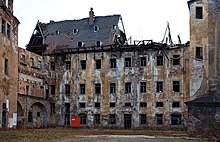Zwickau prison
The Zwickau prison was a prison founded in the 18th century .
history
The breeding and workhouse Zwickau was the Oberkonsistorial President Baron Peter von Hohenthal equipped with 14 prisoners on 15 September 1775 in Castle Osterstein opened (including the granary ) after the 7346 dollars for remodeling the castle using lotteries were procured . The first "caretaker" (director from 1833) was Johann Gottlob Kölz , who had previously managed the Luckau prison. At first the penitentiary was subordinate to the “ Churfürstl.Commission for the procurement of the general poor and orphanages, also breeding and workhouses in Waldheim, Torgau, Zwickau ”. In 1787 the area was extended by a garden on Biergasse and later by a section of the city moat. The western connecting wing was built between 1804 and 1812 and housed around 100 prisoners. In 1817 the nursery was expanded to include the Bley garden. In 1820 a separate Catholic chapel was consecrated and in 1887 it was replaced by the Catholic church that still stands there today. Outside of the institution, the chaplain, the institution doctor and the foreman lived in buildings built in 1822 and 1824. In February 1829 the Zwickau institution was dissolved as a penitentiary and most of the inmates were transferred to the Waldheim penitentiary . Instead, a state labor institute for 400 proofreaders was housed in the castle . In 1830, the ornate castle gables were replaced by unadorned ones because they were dilapidated. In 1832 the east wing of the palace was built with a mangle chamber, coal store and what would later become a wash house.
In 1836 a penitentiary was reopened and the 200 correctionists were housed in the armory (now the Kornhaus). In 1863 the east wing of the three-story cell house planned in the shape of a cross was built. The south and north wings followed a year later. The glass roof and the windows in the front sides allowed light to enter the corridors. At least 222 (maximum 364) prisoners could be accommodated in 208 single and five double cells. Political prisoners enjoyed numerous privileges until 1933. They were allowed to use their own clothes and longer use of light as well as self-employment, self-catering, more walks and reading the newspaper.
During the National Socialist era , the SA set up a wild concentration camp in Osterstein Castle , where opponents of the regime were mistreated and killed.
After 1945, the Zwickau prison was again used as a prison until December 31, 1962.
Known inmates
- Hermann Axen , 1935–1938
- Otto Karl Bachmann , 1933–1934
- Walter Ballhausen , 1944–1945
- Rudolf Bartonek
- August Bebel , July 1, 1874 to April 1, 1875 and November 18, 1886 to August 17, 1887
- Franz Ehrlich , 1934–1936
- Otto Galle , 1934-1936
- Georg Gradnauer : May 14, 1895 to October 15, 1895 for insult
- Erwin Hartsch
- Richard Hentsch , May 2, 1933 to May 10, 1933
- Martin Hoop , May 2, 1933 to May 11, 1933 (murdered here)
- Helmut Holtzhauer , 1942–1943
- Rosa Luxemburg , August 26th to October 25th, 1904 for lese majesty
- Karl May , transferred from Leipzig as "Prisoner No. 171" to the "Zwickau Workhouse" on June 14, 1865, released on November 2, 1868
- Johann Most , 1873
- Rudi Opitz , 1937
- Kurt Meier , from 1937
- Kurt Riedel
- Herbert washer
- Ekkehard Schumann
- Alexander Schwab , died in Zwickau prison in 1943
- Kurt Schwaen , May 1937 to July 4, 1938
- Arno Straube , 1933-1934
- Georg von Vollmar , July 17, 1878 to April 25, 1879 for insulting majesty
Web links
- Erich Viehöfer: On the development of the penal system in Saxony in the 18th century (PDF file; 129 kB)
- Memorial Forum - circular. In: gedenkstaettenforum.de. Retrieved December 16, 2017 .
- The establishment of the “early” concentration camps in the spring / summer of 1933 in Saxony. In: stsg.de. Saxon Memorials Foundation, accessed on December 16, 2017 .
- Zwickau. In: tenhumbergreinhard.de. Retrieved December 16, 2017 .
Coordinates: 50 ° 43 ′ 15.7 ″ N , 12 ° 30 ′ 1.3 ″ E
